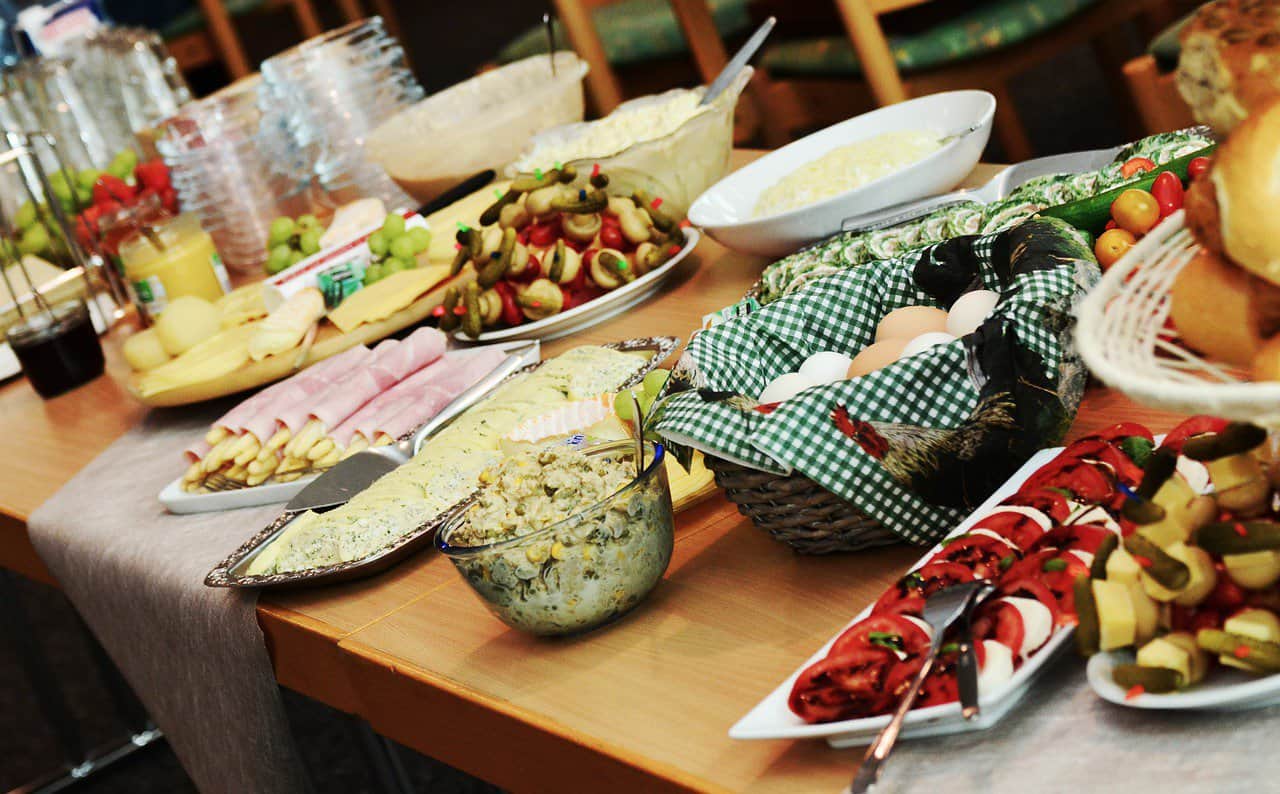When you are tasked with preparing breakfast for a large group, the assignment can be daunting, to say the least.
Where do you even begin with the planning process? Sure, there are the breakfast favorites like eggs, bacon, hashbrowns, and toast, but what if some of your guests have allergies, preferences, or are on a special diet?
These factors must be considered when planning to cook breakfast for a large group.
Cooking for a large group comes down to planning. Knowing the group’s size and preferences is essential before planning the menu. This will determine how the food will be cooked and served to the guests. In addition, it is crucial to understand how to estimate food amounts to prepare sufficient food for the guests.
How to cook breakfast for a large group
Being tasked with cooking breakfast for a group of guests can be a challenge. But it doesn’t have to be overwhelming. Planning is your most powerful tool! Understanding what cookware and cooking techniques will be most appropriate for the number of guests you serve is crucial.
Choosing the wrong serving technique could spell disaster. For example, cooking breakfast al-la-carte (cooking each breakfast order individually and per order) for a group of 50 guests will end up disastrously unless you have a kitchen full of well-trained professional cooks, each with his/her breakfast station. For example, you have a team of cooks. Some will only cook eggs, some will only cook meat, some will only cook pancakes, etc.
But, chances are, that is not the case.
That’s why the serving and the cooking method chosen should be appropriate for the number of guests you serve. If you are limited on kitchen and wait staff, the best option would be to serve your food buffet-style.
Each guest can walk up to the buffet and help themselves. The key to making a buffet work is having a sufficient amount of food ready to serve so that your guests don’t run out of food before everyone can grab something to eat.
Eggs are a staple for serving breakfast. But not all your guests will want to eat eggs for breakfast. How are you going to accommodate those guests? How are you planning on serving your breakfast? How will you keep the food warm, so your guests don’t have to eat a cold breakfast? Where do you even start?
Things to consider when making breakfast for a crowd
A few essential points to consider when cooking breakfast for a large group include size, age, budget, preferences/allergies/dietary restrictions, and what sides you will be serving.
Guest list
The first piece of information you will need is the guest list. How many guests will be attending your breakfast? I think it’s safe to assume that the term ” large group” would imply a guest list of 30 or more guests.
Serving breakfast using a buffet will be the safest option to ensure that all guests can eat simultaneously unless you are serving breakfast to a group of guests that will arrive and leave staggered. For example, golfers that arrive from a tournament may arrive staggered. You could opt to serve al-la-carte, but this is a risky bet.
Alternatively, you could serve breakfast on a buffet and prepare any special requests like sunny-side up, over easy, over medium, or hard eggs, dietary restrictions, or guests with specific allergies al-la-carte.
Budget
What is the budget for your breakfast? This will determine the items you will be serving and how much you will be able to serve. Some breakfast items are more expensive than others. For example, bacon is sometimes more expensive than breakfast sausages. Grilled tomatoes are less expensive than sauteed mushrooms, etc.
Allergies consideration
Be prepared! You may have guests with peanut allergies, gluten, or dairy allergies. In certain extreme cases, like Celiac Disease or peanut allergies, it’s imperative to have stations set up where breakfast can be prepared using ingredients that meet the preparation requirements for these allergies. For example, you cannot prepare breakfast for a person with Celiac Disease on any countertop that has made contact with gluten.
Should you include vegan dishes
Furthermore, some people may be vegan, vegetarian, pescatarian, or gluten sensitive. You should ensure sufficient options on the menu for these guests. You can have a bread station where guests can toast their bread and prepare gluten-free toast upon request in the kitchen.
Age of guests
The age of your guests plays a vital role in breakfast options. If your guests are younger, they may prefer a sweet breakfast with pancakes, muffins, donuts, crepes, French toast, or waffles. You may want to focus more on eggs and bacon for older guests. And, if the age groups are mixed, you should ensure that you have a healthy balance of everything.
And lastly, what side dishes do you intend to serve? Most people enjoy eggs, but the sides are always the main attraction at the breakfast table.
How to plan the process
Now that you have the details of your guest list, budget, and menu, the next step is to plan the cooking process. How long before the event do you start cooking? How much will you serve? Can anything be prepared in advance?
Timing is the name of the game. You want to prepare food to taste fresh and still be warm when your guests arrive. The second important point is that you want your guests to move through your buffet line as quickly as possible. That is why the setup of the line is very important. Ideally, you should set up two buffet lines so guests can move along faster and enjoy their meals.
Luckily, most breakfast menu items are quick to prepare and can be prepared in the morning. You will need a few hours to set up, prep, and cook the food.
Some items like hash browns can be prepped the evening before the event and left in the refrigerator overnight. You can finish grilling the hash browns on the morning of the event. Other items like bacon, scrambled eggs, oatmeal, and pancakes can be prepared a few hours before the event and kept warm before moving to chafing dishes.
Eggs, bacon, hashbrowns, toast, and cereal are always favorites. Make sure you have enough for 1.5 times the total headcount.
Scrambled eggs should be the last item prepared because eggs that stand too long tend to become very rubbery.
Determine the cooking time for the various items. Items that take longer to cook should be prepared first. Items that are quicker to prepare should be cooked closer to serving time. All items should be ready at least 15 minutes before serving time.
Prepare more of the popular food items and less of the not-so-popular food items. In addition, the greater the variety, the smaller the serving portions per head. A safe estimation is that each adult will consume one pound of food and 1/2 pound of food for each child.
What do you serve for the breakfast buffet?
This will depend on your guest list and budget. Ideally, ensure a healthy balance with various options, including meat, vegetables, fresh fruit, and cereal. Some breakfast buffet classics include:
- Scrambled eggs
- Bacon
- Breakfast sausages
- Hashbrowns
- Oatmeal
- Cereal
- Pancakes
- Fresh fruit
How do you set up a breakfast buffet?
Set up the buffet so that similar food items are offered together. Start the buffet line with the meat options: eggs, bacon, sausages, etc. The next options should be the vegetables: sauteed mushrooms, tomatoes, hash browns, etc. Finish the savory line with a selection of bread and toasters so guests can help themselves.
The second buffet line should include sweet items. Start the line with pancakes, crepes, waffles, etc. Then move on to cereals for guests who prefer this option. Add fruits and end the line with condiments such as syrup, milk, sugar, creme, etc.
The idea is to group the items according to importance. The line will be determined by the items you choose to offer. Some buffets may be small with a limited number of items, while others may be large with various items.
Plates should be stacked at the front of the line and silverware at the back.
How do you keep breakfast warm for a crowd?
Chafing dishes are an excellent option to keep food warm in a buffet line. If you have extra staff, you should consider an egg station where eggs are made-to-order, if guests don’t want scrambled eggs, and a pancake or waffle station. This is one way to ensure that your pancakes, waffles, and eggs are very fresh.
How do you keep scrambled eggs warm on a buffet?
There are various chafing dishes or crockpot options that you can use to keep your eggs warm. If you don’t have a chafing dish, keep the eggs warm in a crockpot. Simply set the pot to warm to keep the eggs warm without overcooking them. There are various inexpensive options available that won’t break the bank.
You can keep most of your breakfast dishes chafing dishes. These dishes are designed to keep food warm without drying the food out. They are an excellent choice and investment.
Some electronic chafing dishes come with a temperature dial that lets you control how high or low you want to set the heat while keeping your food warm.

